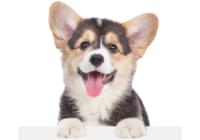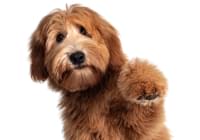Weight Loss in Pets
How do I know my pet is overweight?
A healthy pet's body is proportional -- their ribs can be felt and folds of fat aren't easily seen. An overweight pet has a noticeable paunch, a broader conformation and ribs cannot be seen or felt easily. Fat dogs don't have the "tuck" normally seen in front of the hindquarters. If you look at a normal pet from above, they should have an hourglass look to their body. Overweight animals will have fat pads over the ribs and hip bones.
Your veterinarian can help you in evaluating a healthy weight for your pet. Some animals may have medical conditions which excess weight can make worse.
What causes obesity in pets?
The causes of obesity are really simple: increased energy intake compared to decreased energy output. Typically, your pet is particularly effective at persuading you to indulge his bad habits. Designed to be highly palatable, pet treats are usually high in fat and calories (Example: a typical pet treat = a candy bar).
In households where there may be several pets, food competition increases the potential for becoming overweight. The overweight dog steals from his rival, exacerbating the problem. Along the same lines, households with small children tend to be a great place for your pet to pick up extra treats throughout the day.
Some pets gain weight following being spayed or neutered. This is definitely NOT a reason to not spay and neuter them, as there are many important health reasons to do so. The thing to remember is that your pet may have a decreased metabolism following the procedure. Because of that, you need to take measures to avoid the weight gain that could follow.
Decreased metabolism is also associated with aging. As you pet ages, their caloric requirements decrease. Senior diets carry fewer calories than regular diets because of this fact.
There are medical causes of obesity. These can include hypothyroidism and Cushings disease. If your pet has a sudden weight gain, is having other health problems, or if you cannot get them to lose weight, you should see your veterinarian to screen them for other problems.
Why should I worry about it?
As in people, pets carrying extra pounds of weight place extra demands on virtually all the organs of their bodies. When we overload these organs, disease and sometimes death are the consequences. The health risks to overweight pets are serious and every owner should be aware of them. The more common consequences of obesity are discussed below.
Diabetes mellitus (sugar diabetes) - just like in people, overweight dogs are prone to diabetes. This is an extremely serious disease that takes extreme dedication by the owner to correctly manage.
Damage to joints, bones, and ligaments - Studies have suggested that approximately one-quarter of overweight dogs develop serious joint complications. If they are required to carry excess weight, they can start to damage bones, joints, and ligaments. Arthritis can develop and the pain and joint changes associated with these problems can become markedly more severe.
Certain breeds of dogs, such as Dachshunds are prone to develop intervertebral disc disease ('slipped disc'). Carrying extra weight increases the probability that they will develop this painful and sometimes debilitating condition.
Heart disease and increased blood pressure - As in people, overweight dogs tend to have increased blood pressure (hypertension). The heart has an increased work load since it must pump additional blood to excess tissues. This can lead to congestive heart failure.
Difficulty breathing - In overweight animals, additional fat in the chest restrict the heart and lungs. These changes are especially serious in dogs who may already have a respiratory disease.
Decreased stamina - Dogs who are overweight have less endurance and stamina. Carrying all that extra weight around takes a lot more work. The heart, muscles, and respiratory system are all asked to do more than they were designed for.
Heat intolerance - Fat is an excellent insulator, which is fine if you are a polar bear. But if you are an overweight dog in the heat of summer, the excess fat can make you miserable, and much less capable of regulating your body temperature.
Decreased liver function - The liver stores fat so when a dog is overweight, an increased amount of fat builds up in the liver. This is called hepatic lipidosis. This condition can result in decreased liver function.
Increased surgical and anesthetic risk - increased stress on the heart, liver, and lungs can have serious ramifications during surgery. In addition, many anesthetics are taken up in the fat and must be broken down by the liver, so an overweight animal will take longer to recover from the anesthetic. Beyond that, increased fat in tissues make surgery more difficult and the procedure will take longer, which again increases anesthetic risk.
Digestive disorders - An overweight dog has an increased risk of developing constipation and may also have more problems with intestinal gas and flatulence, which is not pleasant for the dog or the owner.
Decreased immune function - Obesity in the dog is associated with decreased resistance to viral and bacterial infections. The exact cause(s) of this lowered resistance to disease in obese dogs is unknown.
Skin and hair coat problems - The risk of skin and hair coat diseases are increased in dogs who are overweight. The skin forms more and different types of oils, the skin may fold in on itself creating pockets, which are ideal for the accumulation of oils and the development of infections.
Increased risk of cancer - The exact link between obesity and developing certain cancers is unknown. However, there have been studies which suggest that obese dogs tend to have an increased risk of developing certain types of cancers, including a particular type of cancer of the urinary bladder. A recent study also found that dogs who were obese at one year of age were at greater risk of developing mammary tumors.
How do I correct it?
Weight loss for your pet definitely takes dedication on your part. As with people, diet and exercise are the keys to a successful weight loss program.
FEEDING: Before starting weight loss with your pet, you should see your veterinarian to develop a plan, and for recommendations on feeding and exercise. If you pet is on a normal maintenance pet food, they first step is to switch them to a weight loss diet which will have fewer calories. Measure out a specific amount of food to feed them daily, and then weigh your pet every two weeks. If they are not losing weight on the amount of food you are feeding, then decrease that amount by 5 -10% every 2 weeks. If you do not get results with a commercial diet, talk to your veterinarian about prescription weight loss diets.
Make sure that you do any food changes gradually, mixing the old food with the new food over about a week. If you don't, your pet can get an upset stomach, vomiting, and diarrhea.
Crash diets aren't good for pets, especially not for fat cats, who can develop a fatal liver problem if forced to reduce too quickly. Monitor your cat carefully when changing foods - if they stop eating that is an emergency.
A critical part of a diet change is changing treats. If you can give your pet a praise and attention reward instead of a treat, that would be ideal. If not, try low fat treats, carrots, mini rice cakes, frozen peas, or green beans. Remember, most pet treats (or table scraps!) are the equivalent of a candy bar for us, and can really pack on the pounds!
A pet doesn't get fat overnight, and they shouldn't be forced to change course any more rapidly. Weight should be lost gradually, about 15 percent over a two- to three-month period for dogs. At maximum, weight loss should occur at a rate of 1 to 1½ pounds per week for dogs.
EXERCISE: In addition to a restricted diet, you need to provide your pet with gradual increased play and exercise. Make exercise fun, not strict or stressful. Weight loss is definitely a lifestyle change for you and your pet. Carve some time out of your schedule to walk your dog or play with your cat -- three times a week, at least. Be sure to work in some aerobic exercise, anything that gets a cat or dog running.
Dieting Tips
- Make sure that all family members stick to the plan. One person can spoil the results.
- Feed small frequent meals - this helps your pet not feel hungry so much.
- Eliminate treats, especially from the table. These are typically high in fat and calories.
- No free choice feeding! Feed only measured amounts and pick the food back up after about 30 minutes.
- Fun, play and games help reduce weight while keeping your pet happy. They will keep their mind off the loss of food. By keeping your pet's weight at a normal level, they will love a longer, healthier, happier life.
Resources:
Cookies on this website are used to both support the function and performance of the site, and also for marketing purposes, including personalizing content and tailoring advertising to your interests. To manage marketing cookies on this website, please select the button that indicates your preferences. More information can be found in our privacy policy here.
We've upgraded our online store!
Ordering your pet's favorite food and medicine is now easier than ever.
Order Food & Meds
Quick & Easy Registration

Please use the phone number and email you currently use for hospital communications to link your account!
Linked Pet Records & Rx

Your pet's prescriptions and records will be waiting for you!
Pawsome
Savings!

AutoShip discounts, promotions on your favorite products and more!


